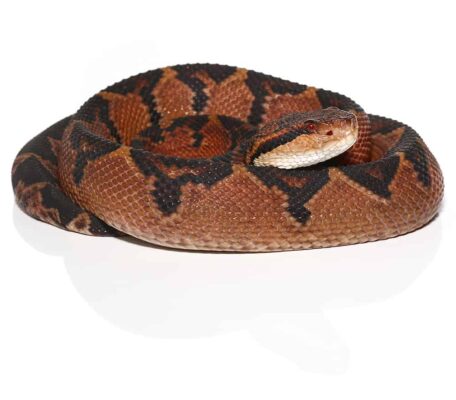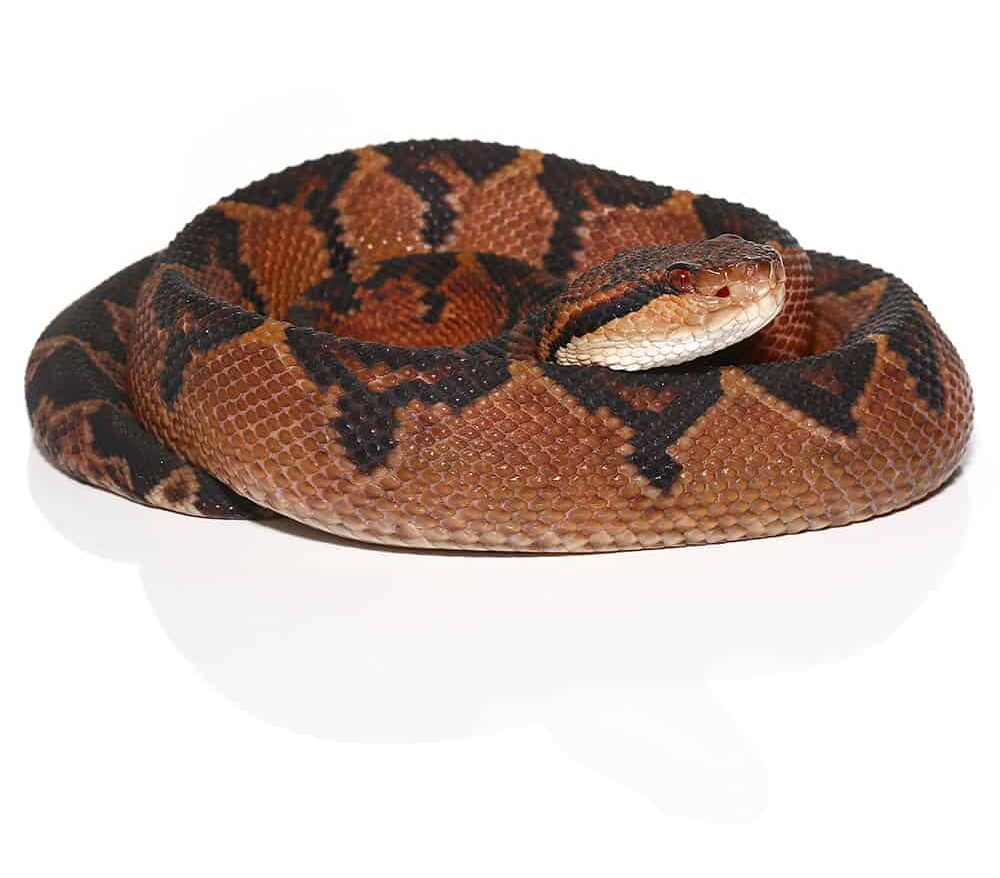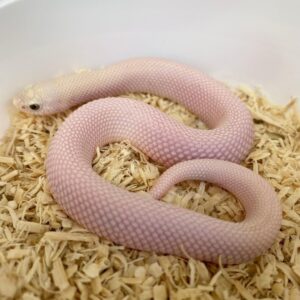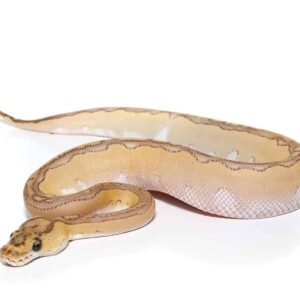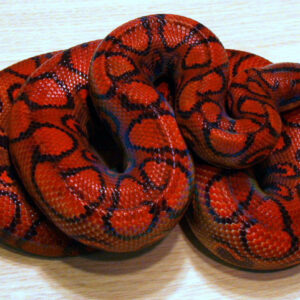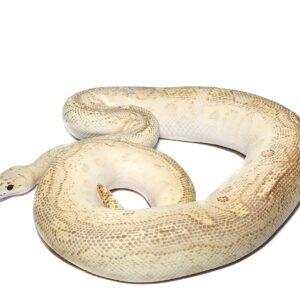Bushmaster For Sale
$2,999.99
WE HAVE A BUSHMASTER LACHESIS FOR SALE. HERE ARE SOME HIGHLIGHTS:
- Lachesis muta
- Also Known As ” South American Bushmaster “
- Field Collected
- Approximately 3 Feet In Length
- Adults Can Grow To Approximately 10 – 12 Feet
- Feeding On Frozen Thawed Or Live Hoppers
- *These Are Venomous. Please Know Your State Laws Before Inquiring As Some States Require Venomous Permits*
FUN FACTS!
- This Genus Of Venomous Pit Viper Snake Ambushes It’s Prey At Night Using Heat-sensing Pits Located Near Its Nose
- Females Can Lay Up To 18 Eggs And Is One Of The Few Snakes Known To Guard Its Eggs
- Name Refers To One Of The Three Fates, Lachesis, In Greek Mythology Who Determined The Length Of The Thread Of Life
- Native To The Forests Of Northwestern South America, Including Colombia, Venezuela, Brazil, Peru, Ecuador, And Bolivia.
- Lifespan Can Be Anywhere From 12 – 18+ Years
Description
The bushmaster, scientifically known as Lachesis muta, is one of the most intriguing and formidable snakes found in the Americas. Commonly referred to as the bushmaster, this snake also goes by other names such as the Atlantic bushmaster and the Surucucú. Renowned for its impressive size and potent venom, the bushmaster holds the title of the largest pit viper in the Western Hemisphere, with some individuals growing up to an astonishing 12 feet in length.
Characterized by its distinctive triangular head, heat-sensing pit organs, and a robust body covered in keeled scales, this snake is a master of camouflage in its natural habitat. This snake’s coloration typically ranges from reddish-brown to yellowish-brown, often with darker dorsal blotches that provide effective concealment against the forest floor’s leaf litter.
The bushmaster’s reputation as one of the most venomous snakes in the Americas is well-deserved. Its venom is a complex cocktail of enzymes and toxins that can cause severe hemorrhaging, tissue damage, and, in extreme cases, death. Despite its dangerous nature, the bushmaster is not aggressive by default and tends to avoid human encounters whenever possible.
Geographically, the bushmaster is predominantly found in Central and South America. Its range extends from Costa Rica and Panama in Central America down through Colombia, Ecuador, Peru, and into the tropical forests of Brazil. This elusive snake prefers humid, lowland rainforests and can often be found in areas with dense vegetation, fallen logs, and abundant leaf litter, which provide ample cover and hunting grounds for its nocturnal activities.
Understanding the bushmaster’s habitat and behavior is crucial for those living in or exploring its range. With its formidable size, potent venom, and secretive nature, the bushmaster remains a captivating yet elusive subject of study for herpetologists and nature enthusiasts alike.
Physical Characteristics
The snake, known scientifically as Lachesis, is one of the most imposing serpents in the world. It stands out due to its remarkable size, often exceeding 10 feet in length, making it one of the longest venomous snakes. The bushmaster’s body is robust and covered with keeled scales, which provide a rough texture that aids in camouflage within its forest habitat.
One of the most distinctive features of the bushmaster is its triangular head, which is notably wider than its neck. This head shape is characteristic of many venomous snakes and houses the snake’s impressive fangs. These fangs are long and capable of delivering a potent venom deep into its prey. The venom is hemotoxic, causing significant tissue damage and disruption of blood clotting.
Coloration plays a critical role in the bushmaster’s ability to remain elusive. Typically, its skin ranges from brown to pinkish-brown, adorned with darker, diamond-shaped patterns along its back. This coloration not only provides an effective means of blending into the leaf litter and forest floor but also enhances its predatory stealth. The patterns can vary significantly among individuals, adding to the bushmaster’s enigmatic appearance.
In addition to its color and size, the bushmaster’s physical characteristics include large, expressive eyes equipped with vertical pupils. These eyes are adapted for low light conditions, allowing the snake to hunt primarily at night. The bushmaster also possesses heat-sensing pits located between its eyes and nostrils, enabling it to detect warm-blooded prey even in complete darkness.
Overall, the bushmaster snake’s physical attributes not only contribute to its survival and predatory efficiency but also underscore its status as a formidable and fascinating reptile within its natural habitat. Its combination of size, coloration, and sensory adaptations make it a subject of great interest and respect among herpetologists and snake enthusiasts alike.
Habitat and Distribution
The bushmaster, a viper belonging to the genus Lachesis, is known for its elusive nature and preference for specific habitats. This snake thrives predominantly in tropical rainforests, which provide the ideal conditions of humidity and dense vegetation. These environments offer ample cover and a rich variety of prey, vital for the bushmaster’s survival. Rainforests, with their complex ecosystems, support the snake’s needs for both shelter and sustenance.
Aside from rainforests, the bushmaster can also be found in lowland forests and other wet or humid regions. These habitats share similarities with rainforests, such as high moisture levels, dense foliage, and diverse animal populations, which are crucial for the bushmaster’s predatory lifestyle. The snake’s ability to adapt to different types of wet environments showcases its ecological versatility.
Geographically, the bushmaster’s distribution spans several countries in Central and South America. In Brazil, for instance, the Amazon rainforest serves as a significant habitat for this viper. The country’s vast and varied forested areas provide an extensive range for the bushmaster to inhabit. In Peru, the snake is commonly found in the lush lowland forests, which offer a suitable environment for its needs.
Moreover, Costa Rica and Nicaragua also host populations of the bushmaster. In Costa Rica, the snake is typically found in the humid lowland forests and regions with high rainfall. The country’s commitment to preserving its natural forests has aided in maintaining the bushmaster’s habitat. Similarly, Nicaragua’s extensive forested areas, particularly in regions with significant annual rainfall, support the bushmaster’s presence.
Overall, the bushmaster’s habitat and distribution are closely tied to wet and humid environments. The snake’s reliance on such specific conditions underscores the importance of rainforest and lowland forest conservation efforts in the countries where it resides. Understanding and preserving these habitats are essential for maintaining the delicate balance of these ecosystems and ensuring the bushmaster’s continued existence.
Behavior and Diet
The bushmaster, a snake renowned for its elusive nature, exhibits a fascinating array of behaviors and dietary preferences. Predominantly nocturnal, this enigmatic serpent is most active during the night, using the cover of darkness to its advantage. During the day, the bushmaster typically remains hidden, sequestered in the dense underbrush or within burrows, ensuring minimal detection by both predators and prey.
Solitary by nature, the bushmaster seldom engages with others of its kind outside of the breeding season. This solitary lifestyle is complemented by its highly specialized hunting techniques. Equipped with heat-sensing pits located between its eyes and nostrils, the bushmaster can detect the infrared radiation emitted by warm-blooded animals. This adaptation allows it to accurately locate prey even in complete darkness, making it a formidable nocturnal predator.
The diet of the bushmaster is diverse, primarily consisting of small mammals, birds, and amphibians. Utilizing a sit-and-wait strategy, the bushmaster remains motionless, blending seamlessly into its surroundings until an unsuspecting prey ventures within striking range. When the opportunity arises, the snake strikes with remarkable speed and precision, injecting a potent venom that swiftly incapacitates its prey.
Small mammals, such as rodents, are a staple in the bushmaster’s diet, providing essential nutrients for its sustenance. Birds and amphibians also feature prominently, with the snake’s ability to climb aiding in the capture of avian prey. The bushmaster’s dietary habits are not only a testament to its adaptability but also highlight the intricate balance of its ecological niche.
In summary, the bushmaster’s behavior and diet are intricately linked to its nocturnal and solitary nature. Its advanced hunting techniques, including the use of heat-sensing pits, enable it to effectively locate and capture a wide range of prey. These characteristics underscore the bushmaster’s role as an apex predator within its habitat, contributing to the rich tapestry of biodiversity in its environment.
Venom and Its Effects
The bushmaster snake, a member of the Lachesis genus, possesses a potent venom that is both fascinating and formidable. The composition of bushmaster venom includes a complex cocktail of enzymes, peptides, and proteins. Among the primary components are hemotoxins, which target blood cells and blood vessels, leading to a cascade of physiological disruptions. These hemotoxins can cause significant damage to the vascular system, leading to hemorrhage and coagulation issues.
When a bushmaster envenomates its prey, the venom acts swiftly to incapacitate, ensuring that the prey cannot escape. The hemotoxic effects result in rapid tissue damage and internal bleeding, making it easier for the snake to consume its meal. In humans, however, the effects of a bushmaster bite can be dire if not treated promptly. Symptoms of envenomation may include severe pain, swelling, bruising, and necrosis at the bite site. Systemic effects can encompass nausea, vomiting, hypotension, and in severe cases, renal failure and death.
The severity of a bushmaster bite underscores the critical importance of immediate medical intervention. Antivenom remains the primary treatment for bushmaster envenomation. The effectiveness of antivenom depends largely on the promptness of its administration. When administered in a timely manner, antivenoms can neutralize the venom’s toxic effects, significantly reducing the risk of long-term complications or fatality. However, due to the rarity of bushmaster bites and the specific nature of their venom, antivenoms for this species are not always readily available, making preventive measures and education about these snakes essential for those living in or visiting their natural habitats.
Understanding the composition and effects of bushmaster venom not only highlights the snake’s evolutionary adaptations but also emphasizes the necessity for awareness and preparedness in areas where these elusive reptiles are found. As research continues, the development of more effective antivenoms and treatment protocols remains a critical goal in mitigating the impact of bushmaster envenomations on human health.
Conservation Status
The bushmaster (Lachesis muta) is a species of pit viper that has long intrigued herpetologists and wildlife enthusiasts due to its elusive nature and formidable reputation. Despite its significance, the bushmaster’s conservation status presents a complex and concerning picture. According to the International Union for Conservation of Nature (IUCN) Red List, the bushmaster is currently classified as “Least Concern.” However, this categorization does not negate the various threats impacting its population.
One of the primary threats to the bushmaster’s survival is habitat loss. As tropical rainforests are cleared for agriculture, logging, and urban development, the bushmaster’s natural habitat is increasingly fragmented. This habitat fragmentation not only reduces the available space for these snakes to live and hunt but also isolates populations, making it difficult for them to find mates and sustain genetic diversity. Furthermore, human encroachment into these areas often leads to increased encounters between bushmasters and humans, which can result in the snakes being killed out of fear or misunderstanding.
In addition to habitat loss, the bushmaster faces significant threats from illegal wildlife trade. Although not as commonly targeted as other exotic species, bushmasters are sometimes captured for the pet trade or for their venom, which is of interest to medical researchers. These activities can further deplete already vulnerable populations.
Despite these challenges, there are conservation efforts aimed at protecting the bushmaster. Various national parks and protected areas within its range provide crucial refuges where the snake can thrive without the immediate pressures of habitat destruction and human interference. Conservation organizations are also working to raise awareness about the bushmaster, educating local communities on the importance of preserving this species and mitigating human-snake conflicts.
To ensure the long-term survival of the bushmaster, it is essential to continue monitoring its population trends and to implement effective conservation strategies. Protecting its habitat, enforcing wildlife trade regulations, and fostering coexistence between humans and these remarkable snakes are critical steps toward safeguarding the future of the bushmaster.
Cultural Significance
This snake, a formidable and elusive reptile, has secured a notable place in the cultural tapestry of the regions it inhabits. This snake, found primarily in the rainforests of Central and South America, is deeply embedded in the myths and folklore of indigenous communities. The bushmaster is often depicted as a creature of mystery and power, revered and feared in equal measure.
In many local legends, the bushmaster is portrayed as a guardian of the forest, a symbol of the untamed wilderness and a protector of nature. Its stealthy and elusive nature has contributed to its reputation as a mystical being, often associated with the spirits of the forest. In some myths, the bushmaster is believed to possess otherworldly powers, capable of bringing both fortune and misfortune to those who encounter it.
These cultural narratives have a profound impact on how the bushmaster is perceived by local communities. For instance, the snake’s reputation as a protector of the forest often leads to a sense of respect and a cautious coexistence. Local populations, aware of the bushmaster’s venomous potential, tend to avoid unnecessary encounters, yet they also acknowledge its role in the ecosystem. This duality of fear and respect underscores the complex relationship between humans and the bushmaster in these regions.
In some cultures, the bushmaster’s name is synonymous with danger and death, serving as a potent symbol in warnings and cautionary tales. These stories are passed down through generations, reinforcing the snake’s formidable status and cautioning against reckless ventures into its territory. Conversely, the bushmaster’s elusive nature also inspires a sense of awe and curiosity, with some communities viewing it as a creature of great wisdom and mystery.
Overall, the bushmaster’s cultural significance is a testament to its impact on local communities. It embodies the delicate balance between fear and reverence, highlighting the deep connection between humans and the natural world. The myths and legends surrounding the bushmaster not only enrich the cultural heritage of these regions but also foster a deeper understanding and respect for the natural environment.
Safety and Awareness
For those living in or traveling to regions inhabited by the bushmaster, a combination of awareness and precaution is crucial to ensure safety. This elusive snake, while fascinating, can pose a significant threat if encountered unprepared. Understanding the habitat and behavior of the bushmaster is the first step in mitigating potential risks.
One of the most effective ways to avoid encounters with the bushmaster is to be vigilant when walking through its natural habitats, such as dense rainforests and tropical lowlands. Wearing sturdy boots and long pants can offer protection, as these snakes are often found on the forest floor. Additionally, using a walking stick to probe the ground ahead can help identify the presence of a bushmaster before stepping too close.
If you do come across a bushmaster, it is imperative to remain calm and slowly back away. Sudden movements can provoke the snake, increasing the chance of an aggressive response. Observing the snake from a safe distance and giving it ample space to retreat is the best course of action. Remember, bushmasters are reclusive by nature and generally prefer to avoid human interaction.
In the unfortunate event of a bushmaster bite, immediate medical attention is essential. First aid measures include immobilizing the affected limb and keeping it at or slightly below heart level to slow the spread of venom. Applying a pressure bandage can also help, but it is crucial not to use a tourniquet or attempt to suck out the venom, as these methods can cause more harm than good.
Education and respect for the bushmaster are vital components of coexisting with this powerful reptile. By learning about its habits and behaviors, individuals can better understand how to avoid dangerous encounters. Respecting the bushmaster’s role in its ecosystem and refraining from unnecessary interactions can contribute to a safer environment for both humans and the snake.
